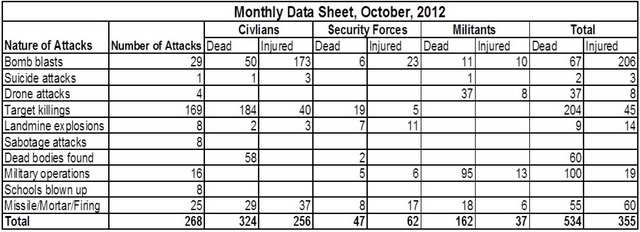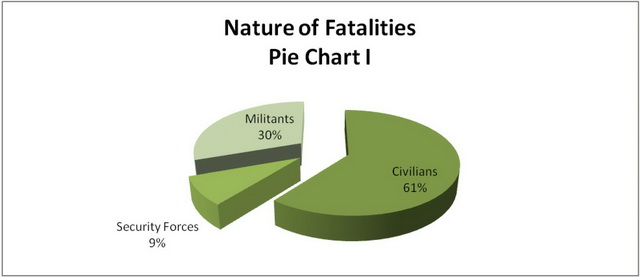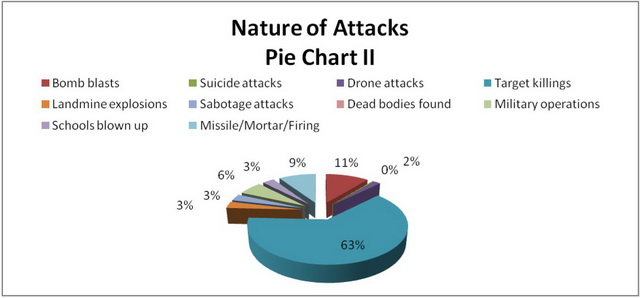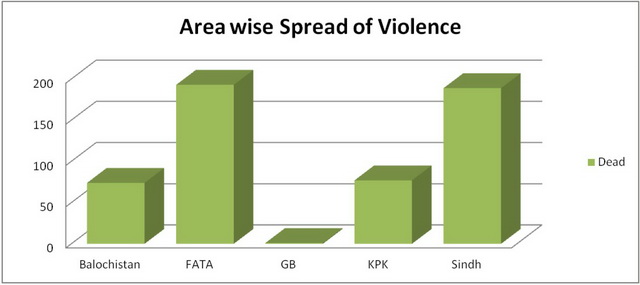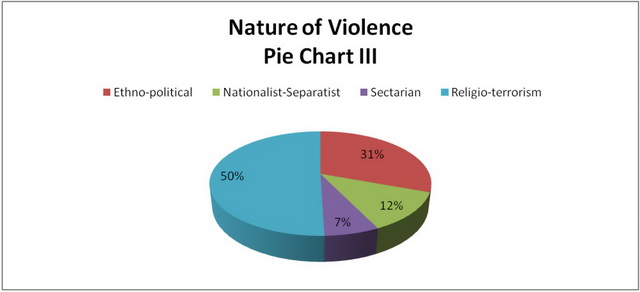The overall level of violence marginally escalated during October across Pakistan. Ethno-political violence in Karachi, religio-terrorism in Federally Administered Tribal Areas (FATA) and Khyber Pakhtunkhwa (KP), and nationalist-separatist violence in Balochistan continued to pile up misery and death toll. The deadly wave of target killing in Karachi, started in the last week of March, continued to rip apart the security in the largest metropolis and economic hub of Pakistan. The deadly wave left almost 140 persons dead during the current month. In total 189 persons perished in Karachi during October in different circumstances. Also, the militancy-ridden areas of FATA and KP continued to seethe under violence, wherein a whopping – 270 persons lost their lives during the month under review as a result of different violent clashes. The data collected throughten newspapers that CRSS uses as the source, suggests that some 534 people lost their lives in 268 incidents of violence across the country (for details see data sheet). The violent clashes also left 355 people injured in October.
A concise look into the casualty figures underlines that the civilians remained the major target of violent actors, with the civilians accounting for 3/5 of the total deaths as a result of various acts of violence and terror in Pakistan. As noted in pie chart I below, civilians were almost 61 percent of the total dead in October. The share of the civilian deaths is slightly higher than the previous month, wherein 59 percent of the dead were innocent civilians. As a whole, 324 civilians were killed in different circumstances during the month. Moreover, the data suggests that the militants fighting against the state remained the second major target i.e. 30 percent (162) of the total dead. Clashes also left 47 security forces– personnel (nine percent of total deaths) dead and these were mostly recorded in insurgency infested areas of FATA, Karachi and Balochistan. Furthermore, during October (from September 28 to 01 November), four CIA operated drone strikes were reported in different areas of North Waziristan Agency (FATA), leaving as many as 37 suspected militants dead. While during last month, three drone attacks were reported, leaving 13 suspected militants dead. Between March and October this year, 36 drone attacks have killed almost 271 suspected militants. Meanwhile, continuing their sabotage campaign to demolish state infrastructure, militants blew up eight state run schools in different parts of FATA and KP during the course of month. Also, eight sabotage attacks were reported in parts of KP and Balochistan provinces, wherein miscreants blew up, two power pylons anda portion of gas pipeline.
In October, target killing was the major cause of deaths. Pie chart II below shows that 63 percent of all the violent incidents were of target killing in nature, accounting for 38 percent of the total death toll. Numerically 204 persons were shot dead across Pakistan, as a result of 169 incidents of target killing. Karachi witnessed the major loss of lives as a result of target killing, wherein 140 persons (68 percent of the total dead in target killings, while 26 percent of the total death toll) were assassinated during the month. Meanwhile, deadly clashes between military and militants were the second major cause of deaths. As a result of which, as many as 100 persons perished, including 95 militants and five security forces personnel in different parts of KP and FATA. Meanwhile, in October, 60 dead bodies were also recovered from different parts of Pakistan, most of them, were found in Karachi, Peshawar, FATA and Balochistan. The third major cause of the violence was bomb blasts. In total, 67 persons including 50 civilians, six security forces– personnel and 11 militants perished in this form of attacks. Likewise, one suicide attacks two persons dead and another three injured in Sargadana Feroz Ghundi area of Hangu district (KP).
A peer into the territory and intensity of violence underlines that FATA witnessed major loss of lives in recent months, wherein almost 193 persons were butchered during October (as shown in bar chart below). After FATA, surprisingly enough, Karachi turned out to be the second major hub of violence, where ethno-political violence left almost 163 people dead during the current month. Meanwhile, violence across KP and Balochistan subsided significantly during the course of the month.
Moreover, the sporadic waves of sectarian violence continued to pile up misery in Pakistan, especially on Shia Muslims. In October, 36 people (seven percent of all the dead) were killed out of sectarian motives; majority belonging to Shia minority sect, in Parachinar (FATA), Quetta (Balochistan) and Karachi (Sindh), as a result of 25 violent incidents. Of the total 25 attacks, 17 attacks, 68 percent took place in Karachi alone killing 72 percent (26) of the total dead in sectarian violence. Latest trends in sectarian violence across Pakistan underscore the fact that this sort of violence is on the rise once again. Shias based in Quetta, Parachinar and Karachi, are among the frequent targets of sectarian militants.
Meanwhile, data relating to the nature of violence suggests that almost 50 percent of the total loss of lives was the direct consequence of religio-terrorism. The epicenter of faith-based violence continues to be FATA and KP. Ethno-political violence involving political parties, meanwhile, led to the decimation of 30 percent of the total deaths. While both nationalist-separatist violence in Balochistan and sectarian violence across Pakistan accounted for almost 19 percent of the total fatalities. Accumulative data of last three months (August-October) shows that 1677 persons have perished across Pakistan as a result of the ongoing wave of violence. Among these, August was the most violent month, wherein large numbers of deaths occurred due to the clashes between military and militants and spree of target killings in FATA, KP and Karachi.
The trends and territory of violence across the country underscore that law and order situation across Pakistan remains volatile, while law enforcement agencies look incapable and ill-equipped to address this persistent volatility of the security situation. Meanwhile, at a time when state security continues to deteriorate; the political leadership looks apathetic as ever to find the solution and erect policy measures to stall this plunge. Against this backdrop, there are ample chances that with the prevalent state of security, violence in the coming days will get even worse due to the political expediencies and the alliances of some religio-political groups with the political parties. Also, the government led by Pakistan Peoples– Party looks reluctant to go after militant groups with religious leanings because of the fear of losing votes in upcoming elections.
Sources
- The News
- Dawn
- The Express Tribune
- Pakistan Today
- Daily Times
- The Frontier Post
- Jang (Urdu)
- Daily Mashriq (Urdu)
- Aaj (Urdu)
- The Nation

